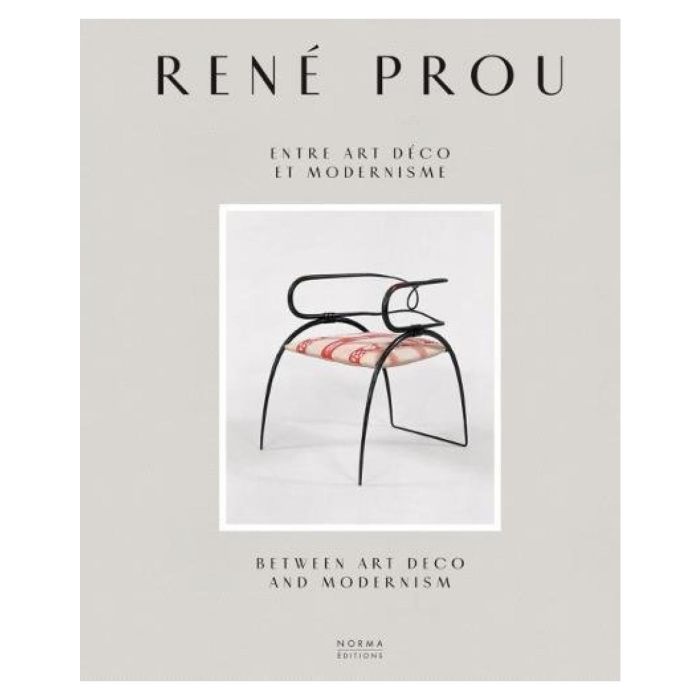My Cart
Your cart is empty
Looks like you haven't made your choice yet.
- Subtotal
René Prou

- Norma Editions
- Anne Bony and Gavriella Abecassis
More Information
| Publisher | Norma Editions |
|---|---|
| ISBN | 9782376660033 |
| Author(s) | Anne Bony and Gavriella Abecassis |
| Publication date | May 2018 |
| Edition | Hardback |
| Dimensions | 305 x 250 mm |
| Illustrations | 350 col. & bw ill. |
| Pages | 240 |
| Language(s) | Eng/ French edition |
Description
The first monograph dedicated to René Prou, a central figure of Art Deco
Contains around 400 documents and photographs
René Prou (1889-1947), an ensemblier and decorator, was - alongside Ruhlmann, Leleu, Dunand, Subes and Brandt - a central figure of the Art Deco movement. Trained at Gouffé, in Paris, in the 1910s, Prou took part in most of the Salons d'Automne and the Salons des artistes décorateurs before commanding attention at the Exposition international des arts décoratifs of 1925. Firmly established by major public and private commissions, his talent as an ensemblier was expressed as much in the decoration of ocean liners - Cuba (1923), Lafayette (1928), Paris (1929) - as in the fitting out of the sleeper cars of the Orient Express; the Palace of Nations in Geneva, where he worked alongside José-Maria Sert, with whom he also collaborated at the Waldorf Astoria in New York; and the furnishing of the Mitsubishi department stores in Tokyo.
His style, defined by the curve of his metal leg blended with a joyous ornamentation, rejuvenated and lightened the full and massive forms of Art Deco while preserving harmony, comfort and a certain idea of simple luxury.
Director of the École de l'Union centrale des arts décoratifs, in Paris, in 1946, his influence marked many postwar talents, including Jean Royère. Text in English and French.
René Prou (1889-1947), ensemblier et décorateur, est, aux côtés de Ruhlmann, Leleu, Dunand, Subes ou Brandt, une figure centrale du mouvement Art déco. Formé chez Gouffé, à Paris, dans les années 1910, Prou participe à la plupart des salons d'Automne et Salons des artistes décorateurs avant de s'imposer à l'Exposition internationale des arts décoratifs de 1925. Consacré par de grandes commandes publiques ou privées, son talent d'ensemblier s'exprime tout autant dans la décoration des paquebots - Cuba (1923), Lafayette (1928), Paris (1929) - l'aménagement des wagons lits de l'Orient- Express, le Palais des Nations, à Genève, où il intervient aux côtés de José-Maria Sert avec lequel il collabore égalment au Walldorf Astoria, à New York, ou encore l'ameublement des magasins Mitsubishi à Tokyo. Son style, défini par le galbe et la courbe des piètements en métal, mêlés à une ornementation joyeuse, rajeunit et allège les formes pleines et massives de l'Art déco tout en préservant l'harmonie, le confort et une certaine idée d'un luxe simple. Directeur de l'école de l'Union centrale des arts décoratifs, à Paris, en 1946, son aura a marqué de nombreux talents de l'après-guerre parmi lesquels Jean Royère.
The first monograph dedicated to René Prou, a central figure of Art Deco
Contains around 400 documents and photographs
René Prou (1889-1947), an ensemblier and decorator, was - alongside Ruhlmann, Leleu, Dunand, Subes and Brandt - a central figure of the Art Deco movement. Trained at Gouffé, in Paris, in the 1910s, Prou took part in most of the Salons d'Automne and the Salons des artistes décorateurs before commanding attention at the Exposition international des arts décoratifs of 1925. Firmly established by major public and private commissions, his talent as an ensemblier was expressed as much in the decoration of ocean liners - Cuba (1923), Lafayette (1928), Paris (1929) - as in the fitting out of the sleeper cars of the Orient Express; the Palace of Nations in Geneva, where he worked alongside José-Maria Sert, with whom he also collaborated at the Waldorf Astoria in New York; and the furnishing of the Mitsubishi department stores in Tokyo.
His style, defined by the curve of his metal leg blended with a joyous ornamentation, rejuvenated and lightened the full and massive forms of Art Deco while preserving harmony, comfort and a certain idea of simple luxury.
Director of the École de l'Union centrale des arts décoratifs, in Paris, in 1946, his influence marked many postwar talents, including Jean Royère. Text in English and French.

René Prou
